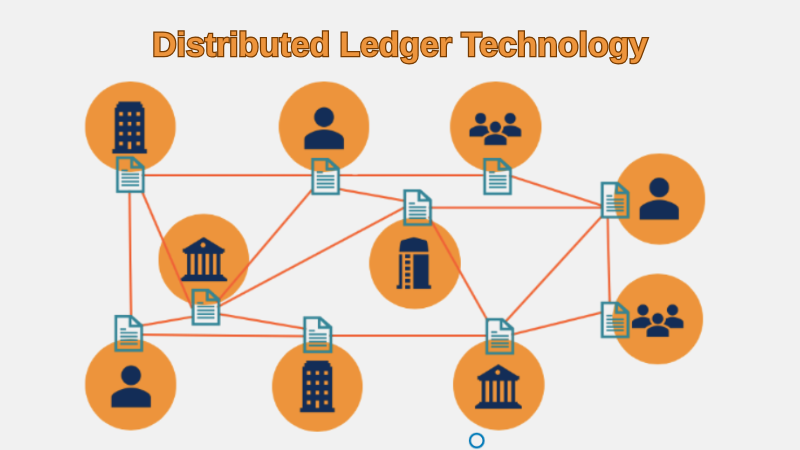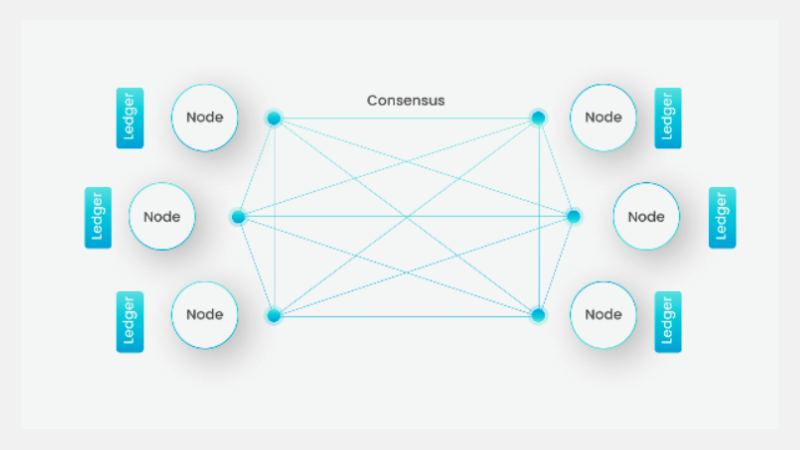Distributed Ledger Technology, or DLT, is the foundational infrastructure and set of protocols enabling multiple parties to access, validate, and concurrently update records in a networked database.
This technology is the building block of blockchains, providing transparency by allowing users to track changes and identify the individuals responsible for them.
Furthermore, DLT simplifies auditing, guarantees data integrity, and restricts access to authorized individuals.
Key Features
- Distributed Ledger Technology grew from distributed computing and is used in many industries, especially for supply chains.
- It is seen in platforms like Ethereum and Fujitsu’s Rice Exchange.
- DLT is decentralized, improves supply chain transparency, and reduces fraud and cyber-attack risks.
- Sectors, including aviation, healthcare, and utilities, have adopted it.
- Distributed Ledger Technology is also used for digital IDs, voting, smart contracts, and property records.
- All blockchains are DLTs, but not all DLTs are blockchains.
DLT Pros and Cons
Distributed Ledger Technology offers various benefits to traditional methods, yet it also brings certain challenges that need careful consideration.
DLT Pros
DLT Cons
How DLT Functions?
Distributed Ledger Technology changes data storage by securely and precisely encoding information through advanced cryptographic techniques.
This data, accessible via unique “keys” and cryptographic signatures, integrates into a tamper-proof database governed by meticulously crafted rules encoded in the database’s programming.
These are the key features of DLT:
- Secure data storage using cryptographic techniques.
- Accessible data through unique “keys” and cryptographic signatures.
- Tamper-proof database governed by encoded rules.
- An immutable database stands resolute, impervious to changes.
While the immutability of distributed ledgers is subject to their programming, blockchains, as decentralized public ledgers, inherently possess this quality, standing as fortresses of data integrity.
Distributed ledgers can be immutable, dependent on programming, as blockchains are inherently immutable due to their decentralized nature.
DLT is decentralized, private, and encrypted – a formidable defense against cybercrime. For an attack to succeed, adversaries would need to compromise all data copies stored across the network simultaneously, a feat nearly impossible to achieve.

Moreover, the peer-to-peer sharing and updating of records lend themselves to a process that is not only efficient and rapid but also cost-effective.
In the intricate web of a DLT network, devices or “nodes” each bears a copy of the ledger, forming a vast tapestry of interconnected data. The network, potentially limitless in its expanse, captures any alterations to the ledger across all nodes.
These nodes then collectively publish their ledger versions, now enriched with the latest transactions.
Network of Nodes in DLT
- Interconnected Data Tapestry: Each node holds a copy of the ledger, creating a vast interconnected tapestry of data that ensures consistency and reliability across the network.
- Synchronized Alterations: When alterations are made, they are meticulously recorded across all nodes, reflecting changes in real-time and preserving the ledger’s integrity.
- Collaborative Publishing: The nodes work in unison to collectively publish their versions of the ledger, each inclusive of the latest transactions, showcasing the power of decentralized collaboration.
- Consensus & Finality: A consensus on the ledger’s validity acts as the final seal, with transactions being finalized, encrypted, and utilized as reference points for future transactions, solidifying the ledger’s role as a cornerstone of blockchain development.
Who uses Distributed Ledger Technology?
Distributed Ledger Technology serves myriad purposes, with its prime function being a scalable platform that empowers various sectors to enhance their operations.
A prime example of this is Hyperledger Fabric, a modular and adaptable DLT framework.
This platform has been pivotal for multiple businesses in developing solutions that permeate a range of industries, including but not limited to aviation, education, healthcare, insurance, manufacturing, transportation, and utilities.
Supplying Chains with DLT
The integration of DLT proves to be a boon for supply chain management, mitigating prevalent issues such as inefficiency, inaccuracies, susceptibility to corruption, and potential losses.
Fujitsu, a global leader in data and information technology, has been at the forefront of this revolution, crafting Distributed Ledger Technology that significantly enhances supply chain transparency while acting as a formidable barrier against fraud through its data securing and tracking capabilities.
Fujitsu’s Rice Exchange:
Fujitsu has created the Rice Exchange platform, a notable innovation in Distributed Ledger Technology.
Here’s what makes it special:
- Rice Trading: The platform is specifically designed for trading rice.
- Detailed Record Keeping: Sources of rice, pricing details, insurance information, shipping logistics, and settlement processes.
- Immutable Ledger: Once data is recorded, it cannot be changed, ensuring authenticity and accuracy.
- Automated Data Entry: Fujitsu has automated entering and securing data on the platform.
- Future Developments: Plans to add a tracking system for rice shipping containers to enhance transparency and accountability.
Distributed Ledger Technology Applications
DLT has demonstrated significant value across various scenarios and industries, transcending its typical financial applications.
Here are some notable instances:
Transaction Records
DLT facilitates transparent and decentralized transactions, eliminating the necessity for a central authority. It adeptly handles both financial and non-financial transaction records.
Digital Identity Security
It provides a robust and unalterable digital identity, ensuring reliable verification and preventing identity theft.
Transparent Voting Systems
DLT can revolutionize voting systems, safeguarding against fraud and upholding the integrity of the electoral process. It records all interactions within a clear, immutable ledger, bolstering the credibility of collected opinions.
Smart Contracts
These automated agreements execute based on pre-defined conditions, such as releasing insurance funds post-claim processing. It mitigates errors and deters malicious activities.
Property Ownership Records
Ensures transparent and tamper-proof documentation of property transactions and ownership transfers. Although translating physical asset ownership to a distributed ledger has limitations, it provides an unalterable source of truth regarding ownership.
Supply Chain Management
DLT optimizes supply chain processes by providing a transparent and unalterable record of product journey from manufacturer to consumer. It streamlines tracking and authentication, reducing inefficiencies and the risk of counterfeit goods.

Why Distributed Ledger Technology Matters?
DLT stands out as a revolutionary means to reconfigure how we record, manage, and disseminate data.
The foundation of its importance rests on three key tenets: security, transparency, and ease of access.
Security
Unlike the conventional ledger systems governed by a singular entity, DLT decentralizes control.
The technology enhances resilience against cyber threats and diminishes the risk of total system crashes. The inclusion of cryptographic methodologies ensures data protection and thwarts any malicious tampering.
To illustrate, in the conventional banking paradigm, a sole authority ensures transaction legitimacy.
However, DLT relies on a consensus strategy, demanding a unified agreement from all participating ledgers for transaction validation. This collective affirmation fosters user trust and eliminates an undue concentration of authority.
Transparency
While many traditional ledgers curtail access, DLT promotes transparency. Instances like voting benefit immensely from this system by ensuring trustworthy, digital, and verifiable voting records.
The key lies in DLT’s deterrent against deceitful activities. Any Distributed Technology activity can be audited by any participant, discouraging fraudulent intents due to the public nature of the ledger.
Accessibility
Distributed Ledger Technology’s potential to democratize access, especially in regions with limited centralized technologies, cannot be understated. Envision the global discrepancies in banking access.
With DLT, transactional data storage requires merely an internet link, sidestepping the constraints of specialized connections like exclusive bank accounts.
As an evolving technology, it offers a fertile ground for innovative breakthroughs and diverse applications. Its inherent accessibility empowers a wider audience to tap into a shared digital realm with minimal bureaucratic obstructions.
DLT’s Decision-making Frameworks
Central to DLT’s operation is its transaction validation methodology. A well-defined, universal system ensures a consensus about the ledger’s content.
Such validation protocols are termed “consensus mechanisms.” While they continually evolve, some widely recognized mechanisms include:
- Proof of Work (PoW): Miners race to decode intricate mathematical challenges to endorse transactions and generate new blocks. Although resource-intensive, PoW’s design ensures that miners have a stake in the validation process, urging them to act honestly.
- Proof of Stake (PoS): This involves validators with a stake in the platform, who are selected for validation based on their stake quantity. While eco-friendly, PoS is vulnerable to the 51% attack scenario where a single entity can dictate the network’s operation.
- Delegated Proof of Stake (DPoS): A variant of PoS, DPoS entrusts a chosen set of validators with transaction endorsement. This model optimizes computational efficiency and fosters a participatory method of electing validators, enhancing scalability.
- Byzantine Fault Tolerance (BFT): BFT hinges on a voting procedure where validators agree. It aims to counteract the Byzantine Generals Problem, a dilemma where decentralized entities must concur, typically depending on a trusted central figure.
DLT vs Blockchain Technology
While blockchain is a form of Distributed Ledger Technology, it exhibits notable distinctions. Blockchain represents a unique infrastructure within the broader category, utilizing a linear arrangement of blocks for recording and validating data.
When comparing the consensus mechanisms, blockchains predominantly employ proof of work or proof of stake protocols, whereas DLTs encompass a wider range of mechanisms.
Furthermore, DLTs demonstrate versatility across various industries, offering solutions to various challenges.
Contrastingly, blockchain is primarily linked with the financial domain, functioning primarily as a payment system recorder.
Regarding security, blockchain adheres to a strict set of criteria, whereas DLTs operate more flexibly.
Key Differences
| Feature | Distributed Ledger | Blockchain |
|---|---|---|
| Data structure | It can be linked but doesn’t necessitate “blocks” | Data is systematically stored within “blocks” |
| Encryption | Optional | Always incorporates encryption |
| Permission | It can be either private and permissioned or completely open | Predominantly public and open, although some variations are permissioned |
| Immutability | Possibility of immutability | Unchangeably immutable |
Future of Distributed Ledger Technology
People see DLT technology as part of a new internet that deals with instant transactions worldwide. DLT exists because the internet is everywhere.
Experts think that how people start using the technology will follow a usual pattern: first, a few trailblazers will try it out, then a larger group will quickly follow, and finally, the slower ones will catch up.
They understand that it’s tough for organizations to start using DLT to make it work well at a larger scale and to fit it into their daily operations.
Right now, it’s up to business leaders, creative thinkers, and pioneers to build networks that can take advantage of DLT. They’re working on ways to keep records better and to create new ways of doing business.
Distributed Ledger Technology (DLT): Conclusion
Distributed Ledger Technology operates on a system where ledgers are housed on different interconnected devices within a network, bolstering data precision and protection.
Blockchains are a progression from distributed ledgers, emerging as a response to the increasing worries over the involvement of numerous intermediaries in various transactions.
Today, Distributed Ledger Technology is integral to contemporary businesses and enterprises striving for precise financial reporting, effective supply chain

